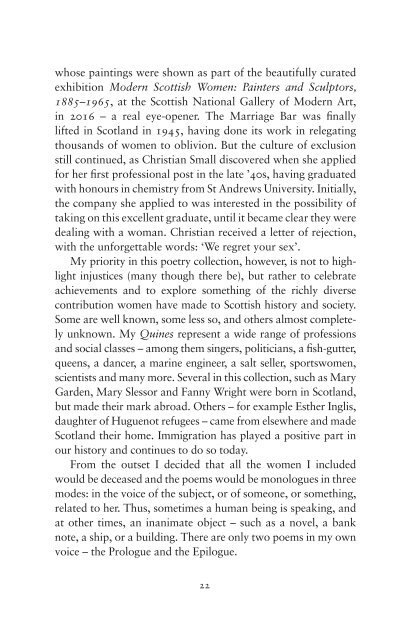Quines by Gerda Stevenson sampler
Quines: Poems in tribute to women of Scotland gives voice to 57 women from BC to the 21st century. The ‘voices’ of the poems range from those of the women featured, to inanimate objects – queens, politicians, a ship, a fish gutter, scientists, a mountain, sportswomen (including a whole football team) and many more. QUINES celebrates the richly diverse contribution women have made to Scottish history and society.
Quines: Poems in tribute to women of Scotland gives voice to 57 women from BC to the 21st century. The ‘voices’ of the poems range from those of the women featured, to inanimate objects – queens, politicians, a ship, a fish gutter, scientists, a mountain, sportswomen (including a whole football team) and many more. QUINES celebrates the richly diverse contribution women have made to Scottish history and society.
You also want an ePaper? Increase the reach of your titles
YUMPU automatically turns print PDFs into web optimized ePapers that Google loves.
whose paintings were shown as part of the beautifully curated<br />
exhibition Modern Scottish Women: Painters and Sculptors,<br />
1885–1965, at the Scottish National Gallery of Modern Art,<br />
in 2016 – a real eye-opener. The Marriage Bar was finally<br />
lifted in Scotland in 1945, having done its work in relegating<br />
thousands of women to oblivion. But the culture of exclusion<br />
still continued, as Christian Small discovered when she applied<br />
for her first professional post in the late ’40s, having graduated<br />
with honours in chemistry from St Andrews University. Initially,<br />
the company she applied to was interested in the possibility of<br />
taking on this excellent graduate, until it became clear they were<br />
dealing with a woman. Christian received a letter of rejection,<br />
with the unforgettable words: ‘We regret your sex’.<br />
My priority in this poetry collection, however, is not to highlight<br />
injustices (many though there be), but rather to celebrate<br />
achievements and to explore something of the richly diverse<br />
contribution women have made to Scottish history and society.<br />
Some are well known, some less so, and others almost completely<br />
unknown. My <strong>Quines</strong> represent a wide range of professions<br />
and social classes – among them singers, politicians, a fish-gutter,<br />
queens, a dancer, a marine engineer, a salt seller, sportswomen,<br />
scientists and many more. Several in this collection, such as Mary<br />
Garden, Mary Slessor and Fanny Wright were born in Scotland,<br />
but made their mark abroad. Others – for example Esther Inglis,<br />
daughter of Huguenot refugees – came from elsewhere and made<br />
Scotland their home. Immigration has played a positive part in<br />
our history and continues to do so today.<br />
From the outset I decided that all the women I included<br />
would be deceased and the poems would be monologues in three<br />
modes: in the voice of the subject, or of someone, or something,<br />
related to her. Thus, sometimes a human being is speaking, and<br />
at other times, an inanimate object – such as a novel, a bank<br />
note, a ship, or a building. There are only two poems in my own<br />
voice – the Prologue and the Epilogue.<br />
22


















